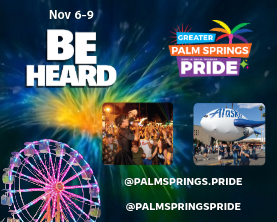By Chris Dorsett
There are so many up and coming new artists who need to be heard. Their voices are now being heard loud and clear and like so many queer artist before them; they are certain to make their mark in history. Many more could have made this list, but the hope of these few is to represent many — and what binds them together isn’t nails, glue, paint or thread, but one common virtue amid this pivotal period for queer culture: When language just won’t cut it, art fills the void.
Leilah Babirye, Sculptor
After fleeing the dangerously homophobic conditions of her native Uganda and gaining asylum in the U.S., Babirye had only art to claim for herself — she left behind family, friends and her girlfriend for the sake of her own survival. Today, she can work from anywhere, creating forms “carved using traditional African techniques mixed with found objects including metal, plastic and wood,” she said. A burned diary, she adds, reflects her own fears and desires about being out, while renderings of trans friends via paper or ceramics “represent some of the most vulnerable members of our community.” She’s taken up activism, particularly as it relates to Uganda’s 2021 presidential election, and she said, “How I live as an out lesbian in the fight for the rights of my community reverberates from New York, through social media, back to Uganda, and all over the world.”
Cheyne Gallarde. Illustrator
“I love to transform queer people into the superheroes I see them as,” Cheyne Gallarde said, “powerful and dynamic but with a touch of whimsy and camp.” Aided by a background in offset printing, Gallarde uses “digital methods to achieve analog results,” and his vintage-style renderings of everyone from Marsha P. Johnson to the cast of “Pose” have become so popular, MTV tapped him to make comic-book covers for all six Video of the Year nominees for this year’s VMAs. “I focus on creating cover art because I want the viewer to imagine the rest of the story in their minds,” said Gallarde, who, when recreating all manner of queer icons, dives into a great wealth of research. In addition to “engaging the viewer’s imagination in this tap-tap-technology era,” Gallarde said he is motivated to shake up who is depicted. “One look at my art makes it clear that I love drawing fierce females,” he said, “but I also love showing trans men and bears represented alongside the muscled Adonises we’ve grown up seeing.”
Gio Black Peter. Painter
“A true artist is never not working,” said Gio Black Peter, a world-renowned, Guatemalan-born painter. “When I’m not painting, I’m thinking about what I want to paint.” Known for his unique style of figure drawing — a touch exaggerated, endearing and provocative — Peter has pulled inspiration from his days in carpentry and gardening, which prompted plants to enter his art. He paints alone in his studio from 9 p.m. until morning, “when New York is the most peaceful,” he said. He admires artists like David Wojnarowicz, who presented fierce commentaries on AIDS before succumbing to complications from it. “It takes guts to put everything out there for public consumption,” Peter Sid, adding, “If you want to know how I see the world, just look at my work.”
Lex Barberio Photographer
Miami-born photographer Lex Barberio likens her artistic process to cooking. “Once you’ve put in all the prep work,” she said (in this case, concept development, test shots and more), “the execution becomes easier.” Barberio said she hopes “to expand people’s definitions of gender, sexuality and self,” and one way she’s doing that is with her project “The Ambisextrous,” wherein each of her subjects were shot while presenting as masculine, androgynous and feminine, and the resulting triptychs were merged via printing on holographic paper, allowing the viewer to watch the subjects transform in real time. The novel technique is a show-don’t-tell contribution to the ever-complex conversation around gender identity. “It visually articulates something that’s very hard to put in words,” she explains.
Nao Bustamante. Multimedia Artist
Nao Bustamante has been showing her performance art, sculpture, installation and video work across the globe for more than 25 years, and she still loves the rush of being in production, in a studio or in a performance. “I’m always making,” she said. “The trick is to find space in your mind to allow for ideas to unfold, and there’s a lot of procrastination involved. I always say, ‘If you’re not procrastinating, you haven’t started yet.’” Known for her bold explorations of race, class and gender, Bustamante said she doesn’t so much make art for the LGBTQ community, but that the community holds and supports her so that she’s able to make her art (including works like “America, the beautiful,” in which she sculpted her body in packing tape to “create the perfect feminine form, which in turn becomes grotesque”). She remains motivated to build a more just and loving world, and more reflective of her own lived experience. “I stand at the intersection of many communities: queer, feminist, Latinx, artist and educator,” she said. “I live all those identities at the same time.”
Marco DaSilva. Painter
This past summer, at New York’s Manny Cantor Center, DaSilva exhibited a series of paintings with combined canvases — each painting created the shape of the Empire State Building, and each bore the colors of a different flag representing a past lover. “It was inspired by unrequited desire,” DaSilva said. “I’m influenced by navigating queer love in my work but coding it in a way that only I can fully understand. The viewer is left to pick up the pieces.” Motivated by fellow queer artists and prone to embedding inexpensive baubles in his work (he’s made intricate textures with plastic gemstones, only to cover them with house paint), DaSilva is constantly using his art to negotiate his Brazilian roots with his life and upbringing in New York City. “Through this work I explore the idea of home and sense of belonging that is not rooted in one place,” he said, “but often floating between many.”
Austin James Smith. Designer “Some people have trouble thinking that things outside of drawing, painting and sculpture can be considered in a fine art context,” said Austin James Smith, whose face is typically the canvas for his “dark but whimsical” adornment work. “I enjoy being outside that bubble.” Smith — who recently launched an accessories line, Empty Jewels — said he needs to be fast and consistent when applying makeup, jewelry and more to his face, because he “can’t pause covered in fake tattoos and just pick it back up the next day.” Smith’s Instagram presence has boosted his popularity, and he’s grateful to live in New York, where he can express himself freely — a privilege underlined by his recent collaboration with a Russian artist on an Instagram filter. “He expressed how hard it is for him there,” Smith said, “and that seeing artists like me helps him escape daily negativity. I’m motivated to be my true self while also reaching people.”



